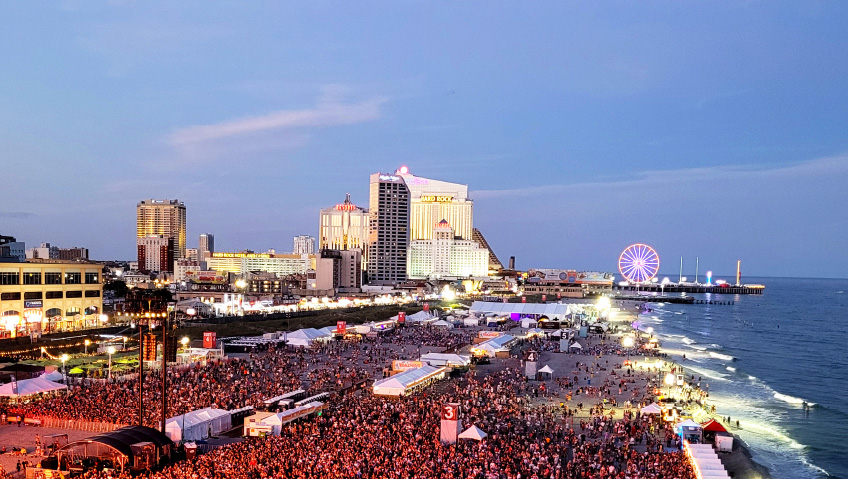The biggest Atlantic hurricane on record by diameter, Hurricane Sandy struck New Jersey’s Atlantic City in late October 2012 with winds of up to 91 miles per hour. By the time it was over, lives had been lost, homes and businesses destroyed, and Atlantic City’s legendary boardwalk, with its roots going back to 1870, was ruined.
The city, known worldwide for its beautiful beaches, resorts, convention centers, casinos, and entertainment venues, came together and rebuilt.
Atlantic City faced consecutive challenges, including the foreclosure crisis, recession, and COVID-19. The collective economic impact of these crises also changed the landscape of neighborhoods and industries, while demonstrating the tenacity and resilience of Atlantic City, including a fully operational municipal government throughout the pandemic. Following the easing of pandemic-related restrictions and the growing popularity of online gambling, Atlantic City’s casino revenues increased 10 percent, with total casino revenue going from $4.7 billion in 2021 to $5.2 billion in 2022.
“This has always been a resort city,” says Jacques Howard, Atlantic City’s Planning and Development Director. Having joined the team in 2020 as Assistant Planning and Development Director, Howard was promoted to his current position in 2022.
In 1978, Atlantic City became home to Resorts International, the first legal casino on America’s east coast. “It was always a town where gambling occurred, and a town known for its premier entertainment… the town was buzzing. And with the creation of the casinos, it localized and vertically centralized activities.”
Casinos and so much more
As a barrier island, the planning and development of AC is a unique process, shaped in large part by its vulnerability to environmental and climate impacts. Planning and development were strong before 1978, but after that, the city saw changes from local, state, and federal perspectives, particularly from the U.S. Environmental Protection Agency (EPA). Regulations were instituted governing the quality of water, air, and soil, the protection of certain species and waterfronts, and more.
Today, these EPA regulations continue to shape development strategies in Atlantic City, and other areas throughout the U.S. “So our role has been amplified to take into consideration these environmental concerns,” says Howard, “and most recently, with the concept of JEDI (justice, equity, diversity, and inclusion) and the governor of New Jersey instituting new regulations to advance what we call environmental equity.”
Planning comprehensively for the City, therefore, now requires a greater focus on the impact of climate change on development, neighborhoods and resilience. Historically, waste plants and other noxious developments have frequently been located in areas that are poor, Black, and non-white, adversely affecting these communities. “So the move now is to mitigate those effects, and this encompasses those elements as well as the broader issue of climate impact changes,” Howard explains.
Buttressing the barrier islands
Famous for its history, entertainment, attractions, casinos, and sparkling depictions in film and television dramas like the Prohibition-era Boardwalk Empire, Atlantic City is also known as a barrier island. Forming a barrier between the mainland and the Atlantic Ocean, it helps to protect the mainland from wind, waves, and strong currents.
Rutgers University’s Center for Coastal and Environmental Studies said that New Jersey’s barrier islands mean many things to different people, such as fishing, clamming, attractive spaces for both beach-goers and bird watchers, and glittering Atlantic City casinos. However, barrier Islands have their downside.
While proving “a refuge from the problems and rush of daily life,” according to New Jersey’s Barrier Islands: An Ever-Changing Public Resource, “Barrier islands are inherently unstable: they move and change shape in response to storms, tides, winds, and human efforts to create stability.”
With this in mind, New Jersey has seen climate impact studies and key recommendations, some specifically related to a predicted rise in sea levels. And with Atlantic City itself a barrier island, it is the most affected by proposed legislation and regulations that can affect redevelopment activities and the preservation of neighborhoods within Atlantic City.
Canal care
Much of Atlantic City is built on infill, and as a barrier island, the city, in its early days, identified ways to mitigate flooding. These included the Baltic Avenue Drainage Canal. Originally built in the mid-1800s, the Canal runs underneath the city from one point to the other, drawing the overflow of water and dumping it out on the other side of the island.
In late 2020, the Baltic Avenue Canal reactivation project was created following a federal grant of $2.45 billion. The Canal’s deteriorating old wooden structures were upgraded with new pumps and gates. With built-in resiliency measures for long-term durability, the height of some bulkheads was also increased to eight feet, helping mitigate flooding in key neighborhoods.
“We have pump stations in addition to floodgates and the Baltic Avenue Canal,” says Howard, adding that, “the reconstruction of bulkheads and the existing jetties and beach replenishment take place regularly.”
Along with flood mitigation measures, the city was also recently part of a major study, along with five municipalities in Atlantic County, called Atlantic County Coastal Resiliency. “That study presented any number of innovative means by which we could preserve the integrity, to the extent possible, of the city’s neighborhoods and the city’s ability to create development while at the same time recognizing the need to create open spaces as well,” shares Howard.
“Specifically, our role is everything that is planning-related: from a concept plan to an adjustment to an existing zoning ordinance, to redevelopment and/or new development, which would include all kinds of projects—anything from residential to mixed-use, industrial, or institutional,” says Howard.
Some of the Planning and Development Department’s many responsibilities encompass planning and zoning boards, redevelopment plans, conveyance of properties, auction sales, and revocable licenses. “There’s quite a range of activities that we’re responsible for—everything from resiliency issues and sustainability to circulation to building development—plus urban agriculture.”
Working toward the future
While many of Atlantic City’s longtime industries remain—such as clamming, shellfishing, and candy manufacturing (it is where saltwater taffy originated in 1883)—the area is welcoming new sectors, including offshore wind. A decade ago, a mini wind farm was established through the Atlantic County Improvement Authority (ACIA). Atlantic City and surrounding areas are ideal for offshore wind, owing to their waterfront access and deep harbors.
“The state of New Jersey wants to be the lead entity throughout the Atlantic coast for wind-generated energy,” says Howard, adding that two giants of the green energy sector, Ørsted and Atlantic Shores, now have a presence in the state.
Realizing offshore wind farms will require workers in the future, Atlantic Cape Community College recently established the new, 1,700-square-foot Wind Training Center at its Worthing Atlantic City campus. It was financed as part of a state grant of almost $3 million to further grow New Jersey’s offshore wind sector. This initiative and others, such as supporting the blue economy—everything derived from the sea—and working on an innovation zone for start-up companies, will see the city’s economy expand into other areas.
“In our case, we would be creating a district that would hopefully be populated with the opportunity for flex space and a reason to come in,” says Howard. “We’re trying to increase the perception and the reality of the city as a family destination, but we’re also looking to diversify the city’s economy.
While many still think of Atlantic City as strictly a gaming town, it is changing under Mayor Marty Small, Sr., who is leading the transformation of this legendary spot into more of a family destination. “This upcoming Memorial Day Weekend, we will see Atlantic City open the world’s largest indoor / outdoor beachfront waterpark, at the same location that recently opened the largest arcade on the East Coast and an indoor go-kart track. Mayor Small has taken initiatives to build up our entrepreneurial force by creating an Entrepreneurial Center, and has undertaken several other initiatives to attract growth industries and increase future job opportunities for the residents of Atlantic City,” says Howard.
And this vision, underpinned by smart and mindful planning, is sure to play a key role in shaping the area’s bright future.













